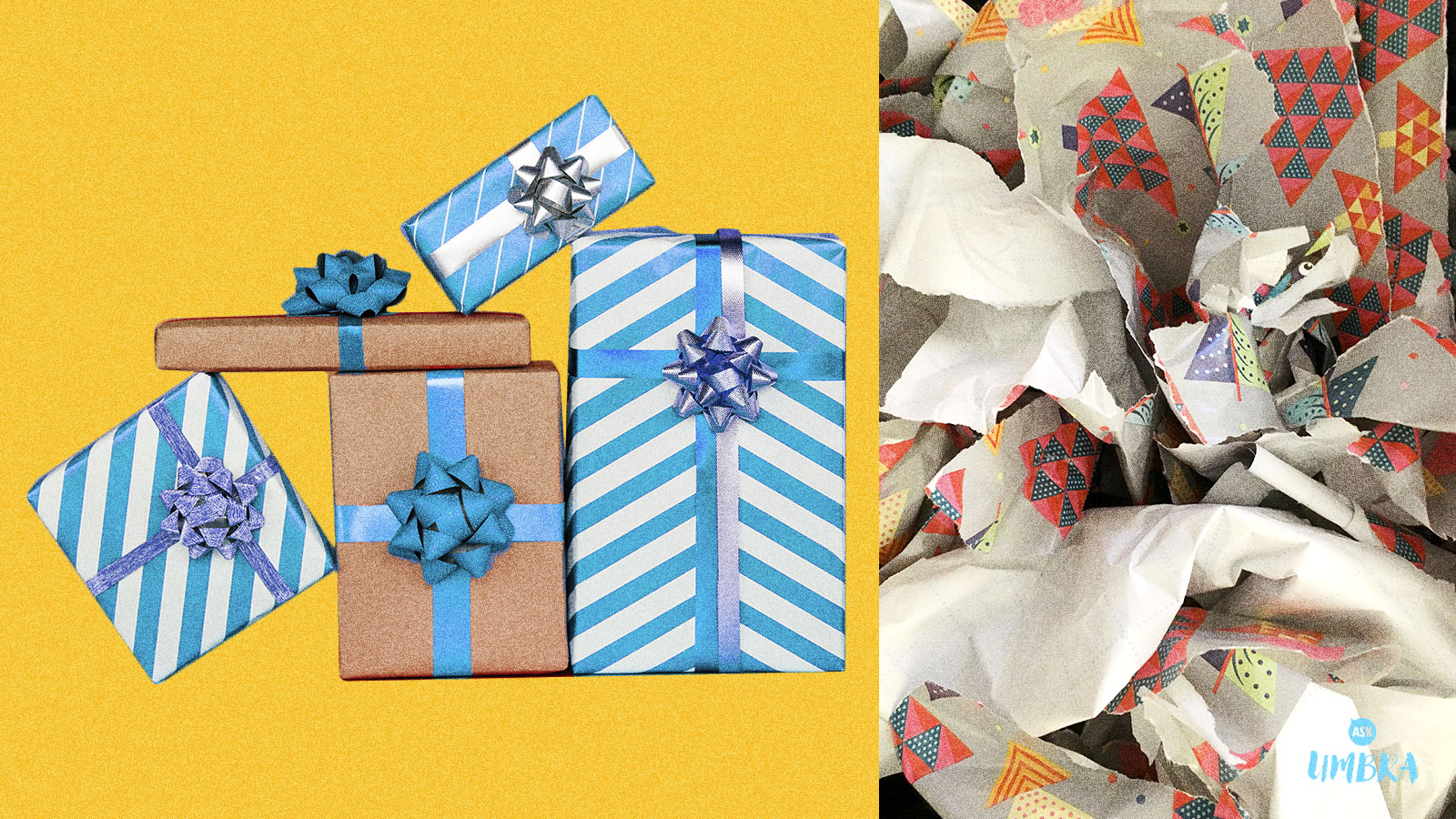Q.Dear Umbra,
My family compulsively reuses wrapping paper, to the point that I think we’ve got some from decades ago. What is wrapping paper made from, how scary is it, and most importantly, should everyone become hoarders like my family?
— Giving In Family That Expects Reuse
A.Dear GIFTER,
Present wrapping is sort of the apotheosis of an environmentalist nightmare. You’re taking a gift (symbol of consumerism!) and dressing it up in shiny paper and bows and frills (single-use products!) that will be immediately discarded (landfill waste!). This is probably why environmentalists have long been considered “no fun.” Because wrapping — and, perhaps more accurately, unwrapping — presents is fun! It’s an experience replete with surprise, beauty, generosity, and other good stuff.
There are more environmentally sound ways to do it, of course. As you already do, keeping and reusing wrapping paper and ribbon and gift bags over and over again, for years and years, is an admirable option. Avoid metallic and glittery paper, because those contain plastic or aluminium that prevent them from being recycled with paper products and therefore go straight to the landfill. (And try to strip excess tape and sticky tags and whatnot from the paper before you recycle it, but a couple of stray pieces probably won’t hurt.) Fabric ribbon is preferable over the plastic curl-able kind, because you can more easily keep and reuse it. The more hardcore enviro-heads use brown kraft paper, which is eminently recyclable, compostable, and reusable, and you can draw stuff on it, stick some pine sprigs in the ribbon, go wild!
As to how scary wrapping paper is, let’s break things down quantitatively. A popular figure that flies around is that the average American household’s waste increases by 25 percent between Thanksgiving and New Year’s, but that’s not specific to gift paraphernalia.
Paper and paperboard packaging make up about 14 percent of all municipal solid waste — an umbrella category that includes trash, recycling, composting, and other kinds of refuse — according to the Environmental Protection Agency, and we can probably assume that percentage is higher over the winter holidays. But paper products are easier and less energy-intensive to recycle than the dread plastic and metal items, so a relatively low percentage of that — around 15 percent for packaging in particular, and 33 percent for all paper* — ends up decomposing in landfills.
Paper products look even better compared to other kinds of holiday waste. Food waste — all those stale holiday cookies, unsolicited fruitcake, leftovers from the elaborate Christmas meal that you made for two people — is a far greater scourge; about two-thirds of all residential food waste goes straight to the landfill, where it breaks down into harmful greenhouse gases like methane. Online shopping for 2020’s holiday season is up by 33 percent over last year, which means 33 percent more of all that plastic packaging that’s most likely not recyclable, to say nothing of the emissions from the ships, planes, and trucks that move all that stuff around.
Is there anything wrong with your hoarding habits? No, of course not. It is never wrong to reuse something as benign as wrapping paper as much as you can or want to. When I talked to Erin Gagnon, a retail sales manager for the West Coast waste management company Recology, about your family’s practice, she said, “I love it, I love it, I love it.” (Three times! She really did!) “We love that people are really thinking through the circular economy,” referring to a system that minimizes waste and maximizes reuse.
But the mantra of any environmentalist’s life, as I’ve said in various ways many times before, should be to not lose sight of bigger, systemic problems, such as the large slice of emissions that come from transportation and manufacturing. If your family members are wrapping 100 Amazon Prime-shipped items in 20-year-old paper, for example, there’s a bit of cognitive dissonance there.
The holidays are theoretically supposed to be about being thankful for the love and generosity in your life, giving what you can to others, and enjoying a lot of warmth and comfort. In practice, there’s often an enormous amount of guilt over the whole rigmarole of gifts — what you paid for them, where they came from, how much they will be enjoyed — and often a healthy dose of depression and inadequacy. Given these existing pressures, I would suggest not holding yourself to absolute environmental purity in every aspect of your holidays.
That said, it’s not that hard to do eco-conscious gift wrapping, and I don’t think it’s an unreasonable burden for most people to make drawers of carefully preserved gift bags and ribbons and sheets of colorful paper dating back several presidential administrations a part of their annual holiday tradition. But I will say it probably matters more, both in a planetary and emotional sense, what’s underneath the paper.
Glitteringly,
Umbra
CORRECTION: This article has been updated to clarify the difference between paper packaging waste and paper waste.



